OLDSMOBILE SILHOUETTE 1993 Owners Manual
Manufacturer: OLDSMOBILE, Model Year: 1993, Model line: SILHOUETTE, Model: OLDSMOBILE SILHOUETTE 1993Pages: 323, PDF Size: 17.13 MB
Page 211 of 323
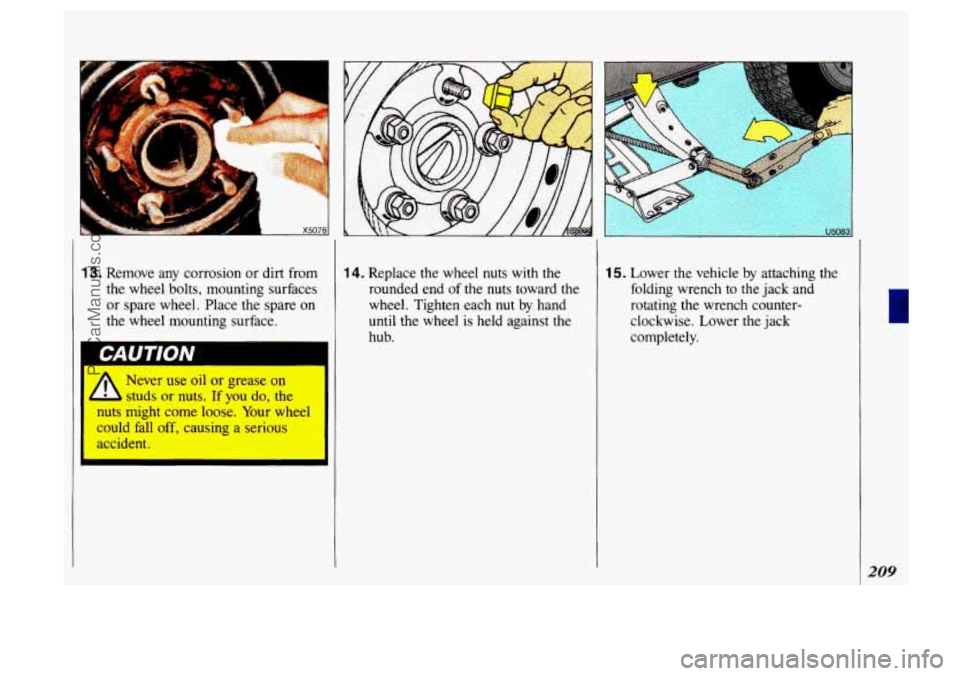
13. Remove any corrosion or dirt from I 14. Replace the wheel nuts with the
the wheel bolts, mounting surfaces
or spare wheel. Place the spare on
the wheel mounting surface.
Never use oil
or grease on I
~ studs or nuts. If you do, the
I nuts might come loose. Your whel
luld fall
off, causing a serious
accident.
1
rounded end of the nuts toward the
wheel. Tighten each
nut by hand
until the wheel is held against the
hub.
1 5. Lower the vehicle by attaching the
folding wrench
to the jack and
rotating the wrench counter-
clockwise. Lower the jack
completely.
1
209
ProCarManuals.com
Page 212 of 323
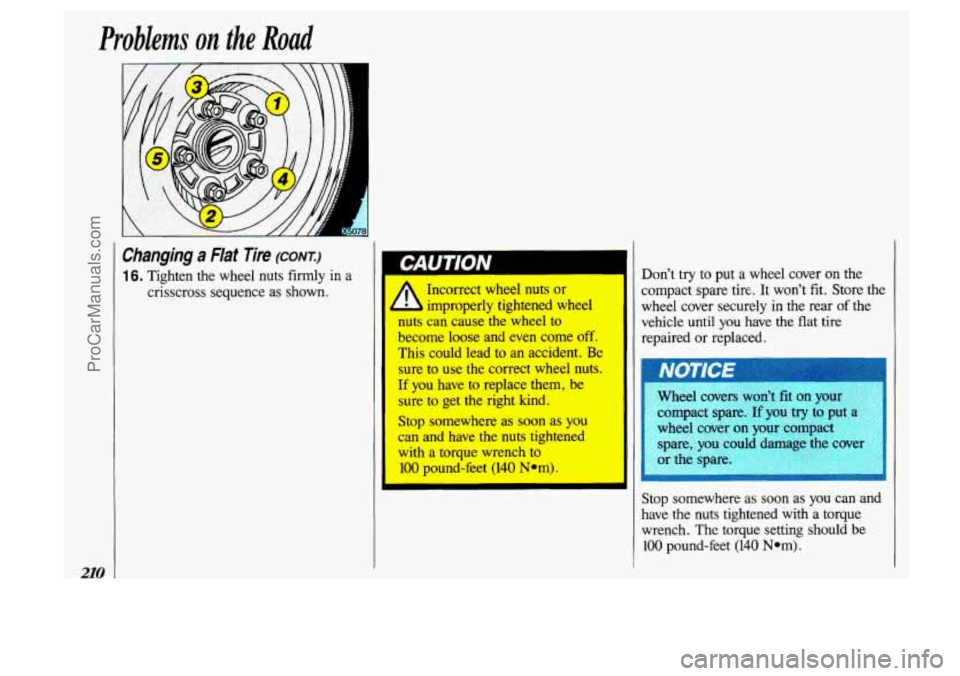
Problems on the Road
210
Changing a FIat Tire (CONT:)
1 6. Tighten the wheel nuts firmly in a
crisscross sequence as shown. Don’t
try to put a wheel cover on the
compact spare tire. It won’t fit. Store the
wheel cover securely in the rear of the
vehicle until
you have the flat tire
repaired or replaced.
..;~ compact spare. If you try to 1
I-
.- wheel cover on your compact
spare, you could damage the cover
Stop somewhere as soon
as you can and
have the nuts tightened with a torque
wrench. The torque setting should be
100 pound-feet (140 Nom).
ProCarManuals.com
Page 213 of 323
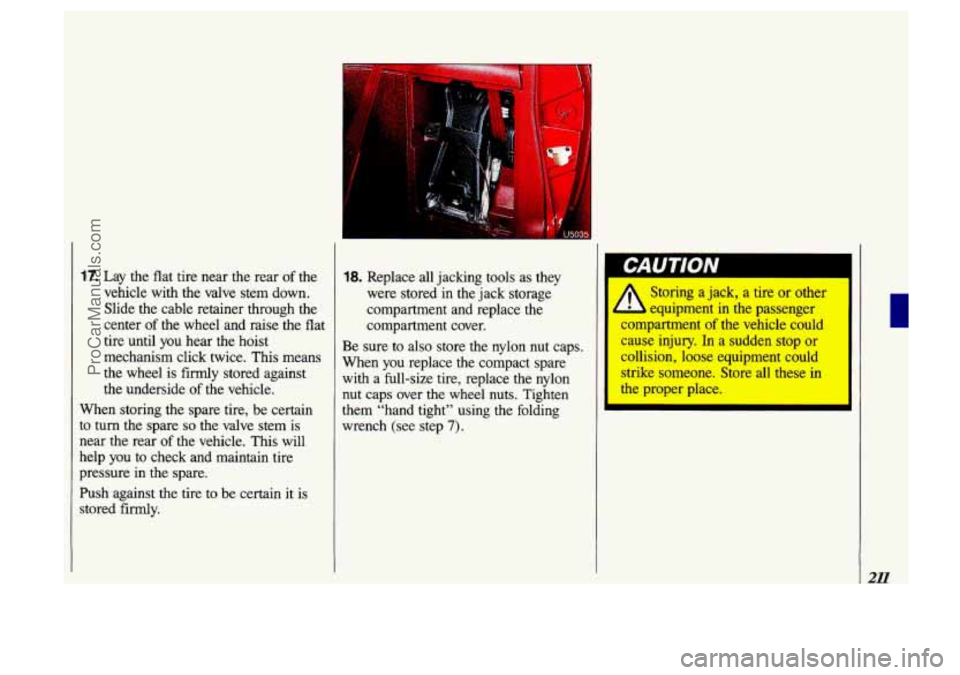
17. Lay the flat tire near the rear of the
vehicle with the valve stem down.
Slide the cable retainer through the
center
of the wheel and raise the flat
tire until you hear the hoist
mechanism click twice. This means
the wheel is firmly stored against
the underside of the vehicle.
When storing the spare tire, be certain
to turn the spare so the valve stem is
near the rear
of the vehicle. This will
help you to check and maintain tire
pressure in the spare.
Push against the tire to be certain it is
stored firmly.
18. Replace all jacking tools as they
were stored in the jack storage
compartment and replace the
compartment cover.
Be sure to also store the nylon nut caps.
When you replace the compact spare
with a full-size tire, replace the nylon
nut caps over the wheel nuts. Tighten
them “hand tight” using the folding
wrench (see step
7).
Storing a jack, a tire or other
- equipment in the passenger
compartment
of the vehicle could
cause injury. In a sudden stop or
~dlision, loose equipment could
>trike someone. Store all these in
the proper place.
211
ProCarManuals.com
Page 214 of 323

Problems on the Road
Compact Spare Tire
Although the compact spare was fully
inflated when your vehicle was new, it
can lose air after a time. Check the
inflation pressure regularly. It should
be
60 psi (420 Pa). The compact spare is
made to go up to
3,000 miles (5 000 km),
so you can finish your trip and have
your full-size tire repaired or replaced
where you want.
Of course, it’s best to
replace your spare with a full-size tire as
soon as you can. Your spare will last
longer and be
in good shape in case you
need it again.
Your anti-lock brake system warning
light may come on when you are driving
with a compact spare. See the
Index
under Anti-Lock Brake System Warning
Light.
Don’t use your compact spare on some
Don’t take your compact spare other vehicle.
through an automatic car wash
with guide rails. The compact
spare can get caught on the rails.
That can damage the tire and
wheel, and maybe other parts
of
your vehicle. And don’t
mix your compact
spare or
wheel with other wheels
or tires. They
won’t fit. Keep your spare
and its wheel
together.
ProCarManuals.com
Page 215 of 323
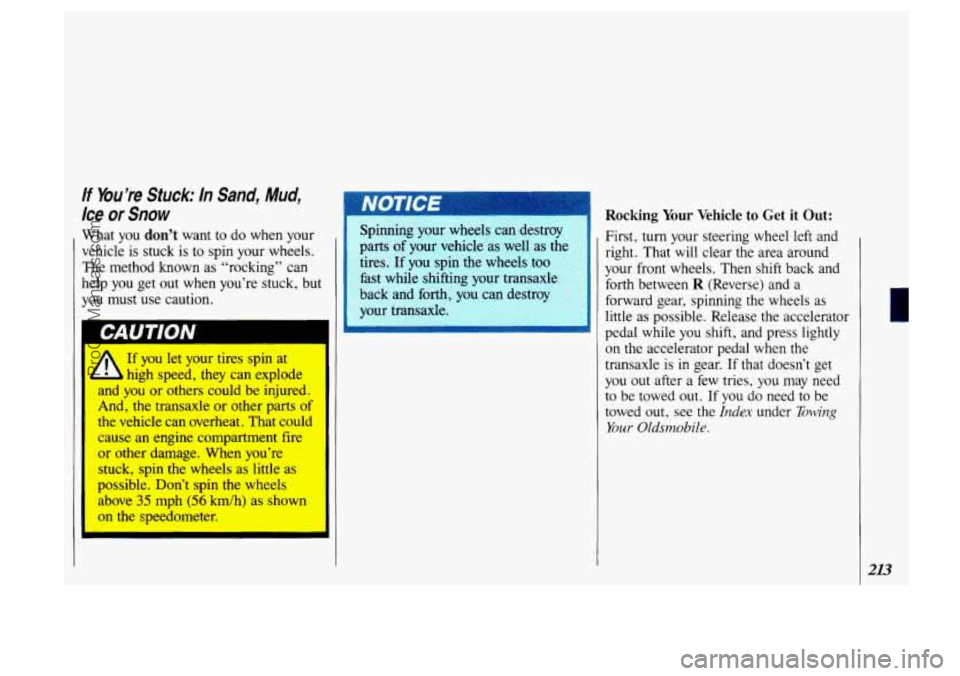
If You’re Stuck: In Sand, Mud,
Ice or Snow
What you don’t want to do when your
vehicle is stuck is to spin your wheels.
The method known as “rocking” can
help you get out when you’re stuck, but
you must use caution.
‘ If you let your tires spin at
high speed, they can explode
and
you or others could be injured.
And, the transaxle or other parts of
the vehicle can overheat. That could
cause an engine compartment fire
or other damage. When you’re
stuck, spin the wheels as little as
possible. Don’t spin
the wheels
above
35 mph (56 km/h) as shown
on the speedometer.
.~.. .. . .
$ back and forth, you can desi
F$ your transaxle.
Rocking Your Vehicle to Get it Out:
First, turn your steering wheel left and
right. That will clear the area around
your front wheels. Then shift back and
forth between
R (Reverse) and a
forward gear, spinning the wheels as
little as possible. Release the accelerator
pedal while
you shift, and press lightly
on
the accelerator pedal when the
transaxle is
in gear. If that doesn’t get
you out after a few tries, you may need
to be towed out. If you do need to be
towed out, see the
Index- under Towing
Your Oldsmobile.
213
ProCarManuals.com
Page 216 of 323

Notes
3
ProCarManuals.com
Page 217 of 323
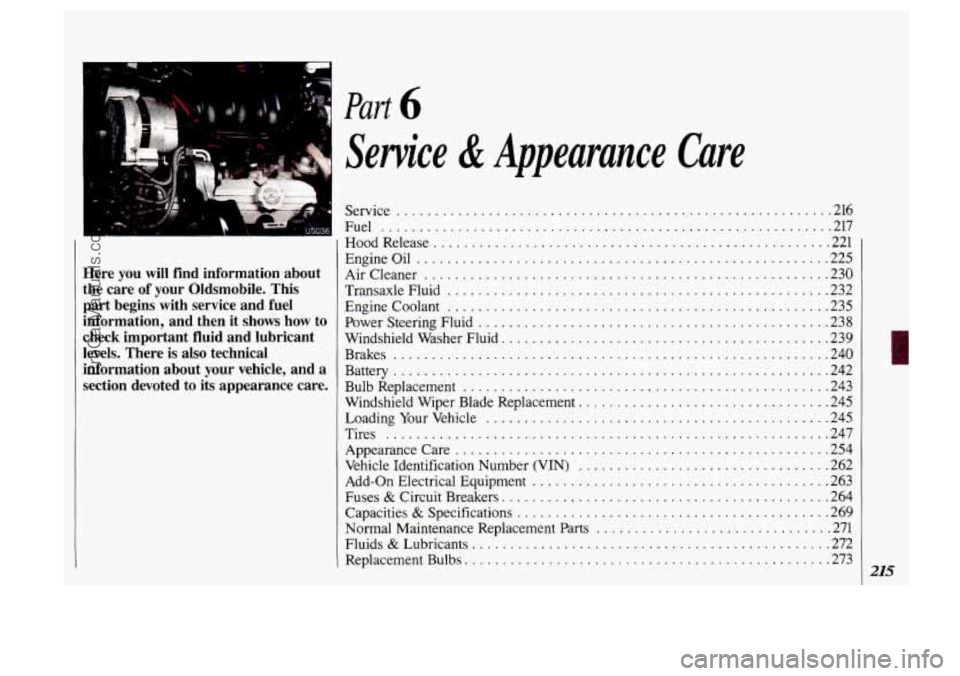
Here you will find information about
the care of your Oldsmobile
. This
part begins with service and fuel
information. and then it shows how to
check important fluid and lubricant levels
. There is also technical
information about your vehicle. and a section devoted to its appearance care
.
Part 6
Service di Appearance Care
Service ......................................................... 216
Fuel ........................................................... 217
HoodRelease
.................................................... 221
Engineoil
...................................................... 225
Aircleaner
..................................................... 230
TransaxleFluid
.................................................. 232
Enginecoolant
.................................................. 235
Power Steering Fluid
.............................................. 238
Windshield Washer Fluid
........................................... 239
Brakes
......................................................... 240
Battery
......................................................... 242
Bulb Replacement
................................................ 243
Windshield Wiper Blade Replacement
................................. 245
Loading Your Vehicle
............................................. 245
Tires
.......................................................... 247
Appearancecare ................................................. 254
Vehicle Identification Number (VIN)
................................. 262
Add-on Electrical Equipment
....................................... 263
Fuses
& Circuit Breakers ........................................... 264
Capacities
& Specifications ......................................... 269
Normal Maintenance Replacement Parts
............................... 271
Fluids
& Lubricants ............................................... 272
ReplacementBulbs
................................................ 273
215
ProCarManuals.com
Page 218 of 323
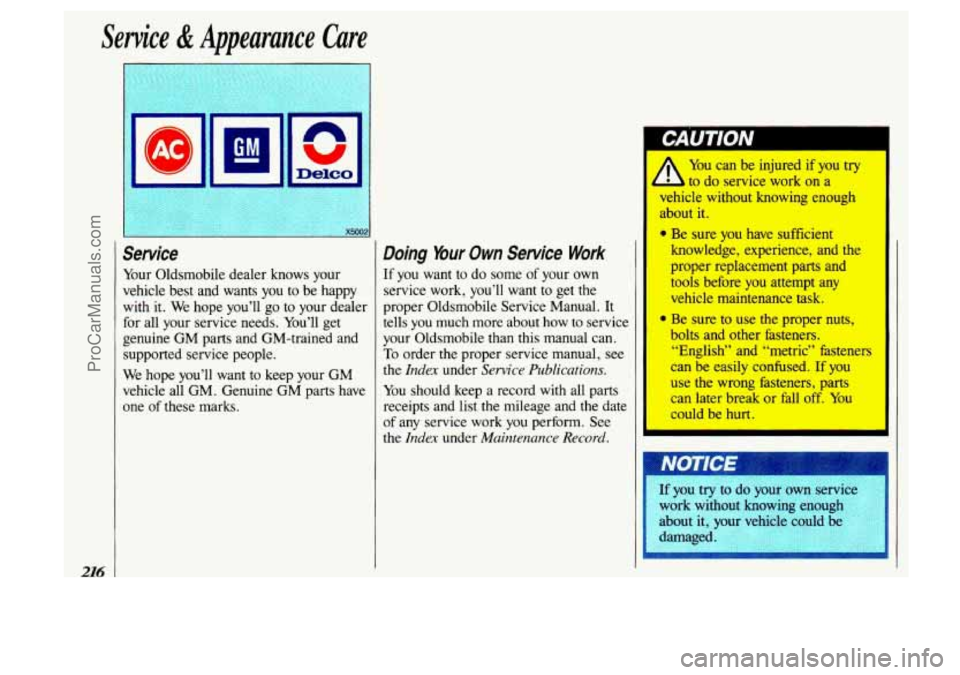
216
~ ~. -s%FsA-?mk
Service
Your Oldsmobile dealer knows your
vehicle best and wants
you to be happy
with it. We hope you’ll go to your dealer
for all your service needs. You’ll get
genuine GM parts and GM-trained and
supported service people.
We hope you’ll want to keep your GM
vehicle all GM. Genuine GM parts have
one of these marks.
Doing Your Own Service Work
If you want to do some of your own
service work, you’ll want to get the
proper Oldsmobile Service Manual. It
tells you much more about how to service
your Oldsmobile than this manual can.
To order the proper service manual, see
the
Index under Service Publications.
You should keep a record with all parts
receipts and list the mileage and the date
of any service work you perform. See
the
Index under Maintenance Record.
ProCarManuals.com
Page 219 of 323
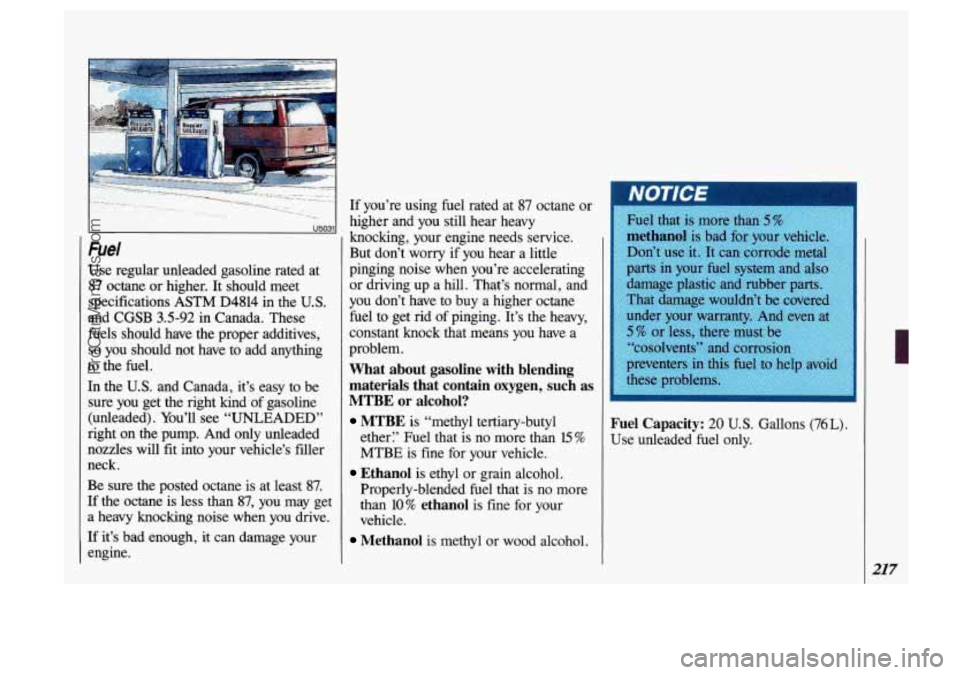
Fuel
Use regular unleaded gasoline rated at
87 octane or higher. It should meet
specifications
ASTM D4814 in the U.S.
and
CGSB 3.5-92 in Canada. These
fuels should have the proper additives,
so you should not have to add anything
to the fuel.
In the U.S. and Canada, it’s easy to be
sure you get the right kind of gasoline
(unleaded). You’ll see
“UNLEADED”
right on the pump. And only unleaded
nozzles will fit into your vehicle’s filler
neck.
Be sure the posted octane
is at least 87.
If the octane is less than 87, you may get
a heavy knocking noise when you drive.
If it’s bad enough, it can damage your
engine.
If you’re using fuel rated at 87 octane or
higher and you still hear heavy
knocking, your engine needs service.
But don’t worry
if you hear a little
pinging noise when you’re accelerating or driving up
a hill. That’s normal, and
you don’t have to buy a higher octane
fuel to get rid of pinging. It’s the heavy,
constant knock that means you have a
problem.
What about gasoline with blending
materials that contain oxygen, such
as
MTBE or alcohol?
MTBE is “methyl tertiary-butyl
ether:’ Fuel that is no more than
15 %
MTBE is fine for your vehicle.
Ethanol is ethyl or grain alcohol.
Properly-blended fuel that
is no more
than
10% ethanol is fine for your
vehicle.
Methanol is methyl or wood alcohol.
Fuel Capacity: 20 U.S. Gallons (76L).
Use unleaded fuel only.
227
ProCarManuals.com
Page 220 of 323
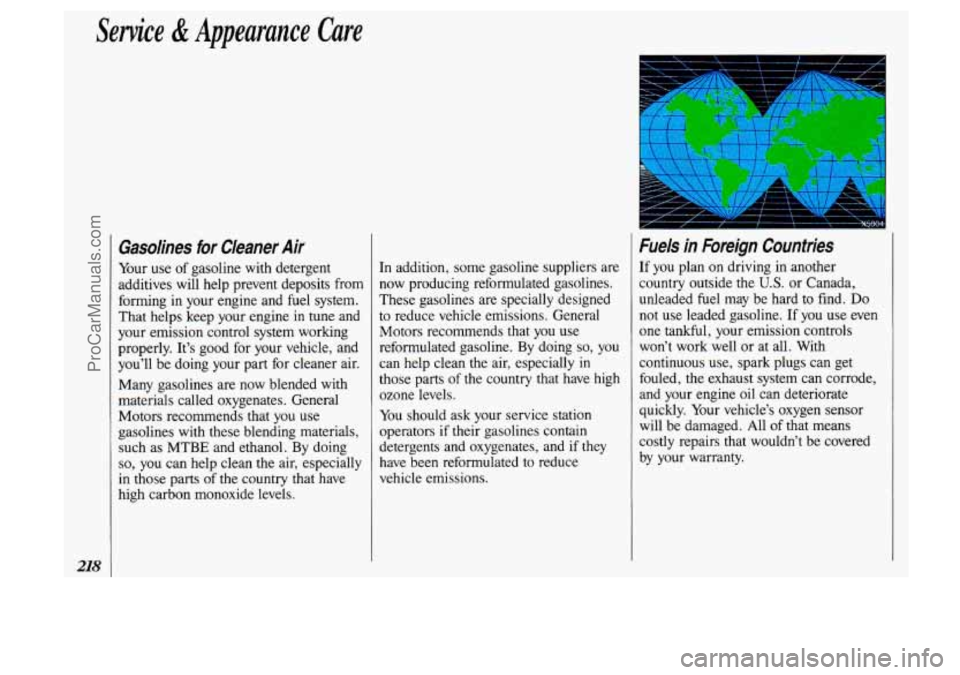
Service & Appearance Care
218
Gasolines for Cleaner Air
Your use of gasoline with detergent
additives will help prevent deposits from
forming in your engine and fuel system.
That helps keep your engine in tune and
your emission control system working properly. It’s good for your vehicle, and
you’ll be doing your part for cleaner air.
Many gasolines are now blended with
materials called oxygenates. General
Motors recommends that you use
gasolines with these blending materials,
such as MTBE and ethanol. By doing
so, you can help clean the air, especially
in those parts of the country that have
high carbon monoxide levels.
In addition, some gasoline suppliers are
now producing reformulated gasolines.
These gasolines are specially designed
to reduce vehicle emissions. General Motors recommends that you use
reformulated gasoline. By doing
so, you
can help clean the air, especially in
those parts of the country that have high
ozone levels.
You should ask your service station
operators
if their gasolines contain
detergents and oxygenates, and
if they
have been reformulated to reduce
vehicle emissions.
”z
Fuels in Foreign Countries
If you plan on driving in another
country outside the
U.S. or Canada,
unleaded fuel may be hard to find.
Do
not use leaded gasoline. If you use even
one tankful, your emission controls
won’t work well or at all. With
continuous use, spark plugs can get
fouled, the exhaust system can corrode,
and your engine oil can deteriorate
quickly. Your vehicle’s oxygen sensor
will be damaged. All of that means
costly repairs that wouldn’t be covered
by your warranty.
ProCarManuals.com